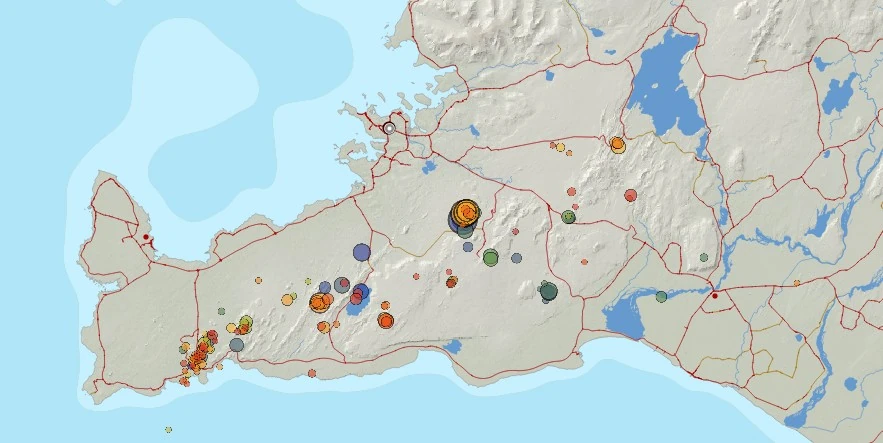University of Iceland professor warns of lava flow proximity to Reykjavík

Þorvaldur Þórðarson, a volcanology professor at the University of Iceland, suggests that recent earthquakes in the Reykjanes Peninsula could indicate magma accumulation under Húsfellsbruna, raising concerns about potential lava flows near Reykjavík.
Þorvaldur Þórðarson, a professor of volcanology at the University of Iceland, has expressed concerns about potential volcanic activity under Húsfellsbruna, a vast lava field situated between Bláfjalla and Heiðmerkur. His observations, published in Morgunblaðin, stem from recent seismic activity in the area, suggesting that the Brennisteinsfjöll volcanic system, located near the Reykjanes Peninsula, may have been activated.
The series of earthquakes in this region has been interpreted as a sign of possible tension build-up at the bottom of the earth’s crust or magma accumulation in the molten rock reservoirs beneath the solid crust. This geological phenomenon is particularly significant considering that during the last eruption on the Reykjanes Peninsula, Húsfellsbruna was the lava that flowed closest to the capital city, Reykjavík.
Professor Þórðarson emphasized the gravity of the situation, stating that it is not out of the question for lava from this area to flow close to Reykjavík, potentially extending even further than during the last eruption. Given these risks, he advocates for the initiation of serious preventive measures and plans, stressing the importance of not relegating such measures to a secondary priority.
He also recalled a historical precedent, noting that the last time an eruption occurred this far north on Brennisteinsfjallariinn, lava nearly reached the sea at Straumsvík.
On January 31, the Icelandic Meteorological Office (IMO) has published its analysis following the seismic activity in the region between Húsfell and Bláfjalla. About 20 earthquakes were recorded last weekend, with the most significant occurring just after noon on Sunday, January 28. The largest earthquakes registered magnitudes of 3.1 at 05:28 UTC on Saturday, January 27, and 2.9 at 12:32 UTC on Sunday, January 28. Notably, one of these quakes was felt in Breiðholt.
Since Monday, January 29, seismic activity in the area has been minimal, with only two small earthquakes recorded, both below magnitude 1.0. While the area has been quiet since then, there remains a possibility that the activity could intensify again. The quakes are located in Húsfellsbruna, north of a fault known as the Hvalhnúksmisgengið.
Kristín Jónsdóttir, head of the department at the Icelandic Meteorological Office, clarified that there are no measurements indicating magma accumulation under the Brennisteinsfjöll. She stated that the seismic activity over the weekend is not attributed to magma movements, as observed in other regions like Fagradalsfjall and north of Grindavík.
The earthquake series between Húsfell and Bláfjalla was linked to the known Hvalhnúksmisgengið fault. This area is prone to so-called bypass earthquakes, a phenomenon common in the South and the Reykjanes Peninsula. These earthquakes result from tectonic stresses accumulating as the North American and Eurasian Plates move past each other. Such tension is typically released in larger earthquakes, believed to occur on the peninsula roughly every 50 years. Given this pattern, another significant Brennisteinsfjall earthquake may be due.
However, Jónsdóttir notes that no signs of land rise have been detected in the data, which would be indicative of magma gathering, as seen in areas like Svartsengi and Fagradalsfjall. She emphasizes the importance of remaining vigilant, as earthquakes originating from the Hvalhnúks Fault are the largest recorded in the Reykjanes Peninsula.
In the event of a magnitude 6 earthquake on the Hvalhnúks fault, it would be felt widely across the country, including the capital area. The main concern would be sharp movements of joints, with the potential to move furniture. However, building standards in the region are designed to withstand such movements without significant weakening of structures.
References:
1 Þorvaldur telur hugsanlegt að kvika sé að safnast saman undir Húsfellsbruna – Hraun gæti runnið nærri Reykjavík – DV – January 29, 2024
2 Jarðskjálftahrina um síðustu helgi á milli Húsfells og Bláfjalla – IMO – January 31, 2024
3 Virknin færist innar: Skjálftar í Húsfellsbruna – Iceland Monitor – January 27, 2024
Featured image credit: IMO

Commenting rules and guidelines
We value the thoughts and opinions of our readers and welcome healthy discussions on our website. In order to maintain a respectful and positive community, we ask that all commenters follow these rules.